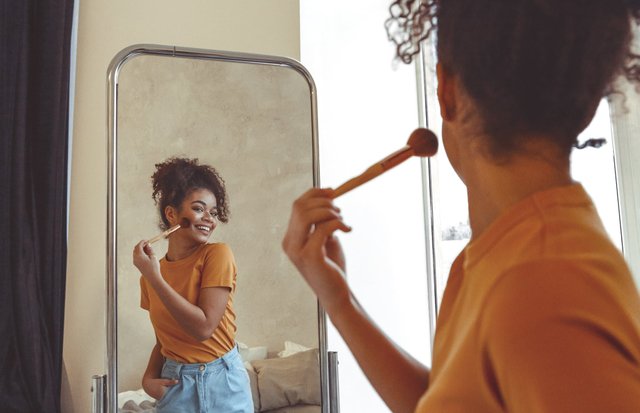Blushing is a natural response to embarrassment or social discomfort. But it can also be a symptom of anxiety.
If blushing becomes a problem for you, talk with a healthcare professional about treatment options. They may be able to suggest strategies that reduce the frequency of blushing or help you manage negative thoughts.
Blushing is a great way to add a soft glow to the skin. But, there are some mistakes that can really ruin your blushing makeup look.
Make sure you apply a good base before you start applying your cream or powder blush. This will prevent your blush from looking blotchy and unflattering on your face.
Another great tip to keep in mind is to always use a light hand when applying your blush. Pick up less product, and then build it up if you need to.
It's also a good idea to use a brush when applying your blush, advises Laramie Glen, a makeup artist in NYC. "A quality brush should be dense, natural or vegan hair and soft."
The way your face is shaped can affect the effect of blush on your complexion. Whether you have a round, square, or heart-shaped face, applying blush with your shape in mind can help achieve a more natural look.
First, identify the most prominent part of your cheekbones and jawbone. Once you’ve determined these bony landmarks, compare them with the width of your forehead and chin.
If the width of your forehead and chin are almost equal, you have a square face. If the length is slightly longer than the width, you have an oval face.
Oval faces have high cheekbones and a wide forehead and jawline, which make the face appear longer than it is. Similarly, square faces have prominent cheekbones and a narrow forehead and chin.
Adding a bit of blush to your face can help define features, highlight high cheekbones, or soften angular areas. Just make sure to apply it correctly, so your makeup look looks as flattering as possible!
Rectangular: The best way to apply blush to a rectangular face is to sweep it along the cheekbones and temples. This will create a wider, more oval appearance and help you appear taller.
Oval: Blush is especially flattering on oval faces, as it can widen the face and make it appear longer. Sweep it over the apples of the cheeks for a healthy rosy glow or dust it onto the skin in line with your contour and up and out on your cheekbones for a more sculpted look.
If you want a more natural-looking blush application, mix it with a little foundation to get that "lit from within" effect. Celebrity makeup artist Katie Jane Hughes recommends sandwiching your blush between foundation and your natural skin to achieve that effect.
Blushing is one of the most common symptoms of anxiety. It’s also a very personal experience, and the way you interpret your blushing will determine how it impacts your life.
While we don’t know the exact evolutionary source of blushing, some psychologists believe that it evolved as a form of self-defense. The sympathetic nervous system triggers increased blood flow in the face when we feel threatened or pressured.
The red facial coloration of a blush is thought to be an indicator of this feeling. It may help other people to recognize that you are feeling embarrassed or tense without having to verbally state it.
Regardless of the origin of blushing, it is a very common symptom of anxiety that can be treated. Working with a mental health professional trained in cognitive-behavioral therapy (CBT) can reduce your feelings of embarrassment and help you to manage the fear and anxiety associated with blushing.

